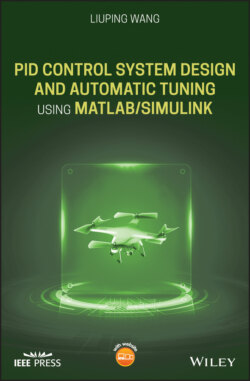Читать книгу PID Control System Design and Automatic Tuning using MATLAB/Simulink - Liuping Wang - Страница 18
1.2.2 Proportional Plus Derivative Controller
ОглавлениеIn many applications, a proportional controller is not sufficient to achieve a particular control objective such as stabilization or producing adequate damping for the closed-loop system. For instance, for a double integrator system with the transfer function:
(1.7)
the closed-loop control system with a proportional controller has a transfer function
which has a pair of closed-loop poles determined by the solutions of the polynomial equation:
These poles are at . Thus, no matter what choice we make for , the system still behaves in a sustained oscillatory manner because the pair of closed-loop poles are on the imaginary axis of the complex plane.
Now, assuming that we will additionally take the derivative of the feedback error signal into the control signal calculation, this leads to
(1.8)
where is the derivative control gain.
The Laplace transfer function of (1.8) is calculated as
Figure 1.3 Proportional plus derivative feedback control system ().
This is what we called a proportional plus derivative (PD) controller.
The closed-loop feedback control configuration for a PD controller is shown in Figure 1.3. For the double integrator system (1.7), with the derivative term included in the controller, then the closed-loop transfer function becomes
(1.9)
(1.10)
The closed-loop poles are determined by the solutions of the characteristic polynomial equation as
which are
Clearly, we can choose the values of and to achieve the desired closed-loop performance.
It is worthwhile emphasizing that almost without exception, the derivative term is different from the original form in the implementation. This is because the derivative term is not practically implementable and the differentiation of the output signal leads to amplification of the measurement noise. Thus, there are a few modifications with regard to the derivative terms. Firstly, in order to avoid the problem caused by a step reference trajectory change (the so-called derivative kick problem (Hägglund (2012))), the derivative action is only implemented on the output signal . Secondly, in order to avoid amplification of the measurement noise, a derivative filter is in a companionship with the derivative term .
A commonly used derivative filter is a first order filter and has its time constant linked as a percentage to the actual derivative gain in the form:
(1.11)
where is typically chosen to be 0.1 (10%). is chosen to be larger if the measurement noise is severe.
With the derivative filter , a typical PD controller output is calculated as
(1.12)
Figure 1.4 PD controller structure in implementation.
where is the filtered output response using (1.11). In a Laplace transform, the control signal is expressed as
(1.13)
Figure 1.4 shows the block diagram used for implementation of a PD controller with a filter.
If the derivative filter was not considered in the design, there is a certain degree of performance uncertainty due to the introduction of the filter. This may not be ideal for many applications. Designing a PD controller with the filter included will be discussed in Section 3.4.1.
